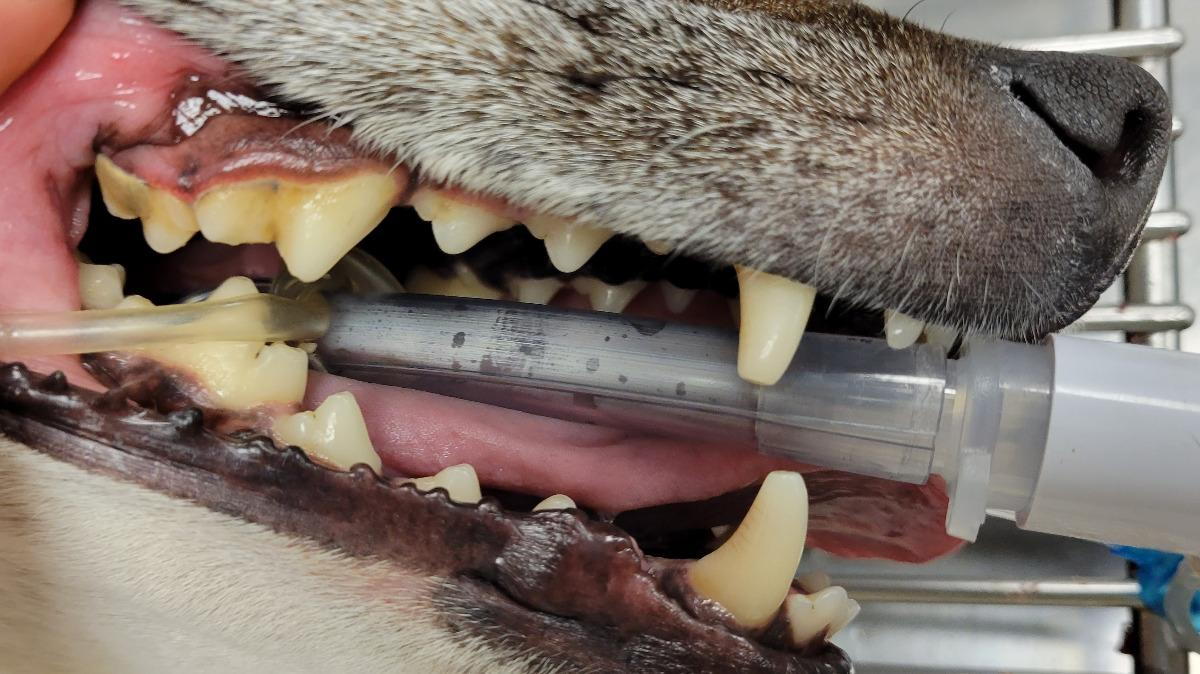Common Dental Problems in Dogs

- posted: Feb. 13, 2022
Common Dental Problems in Dogs
February is Dental Health Month. Last week we talked about common dental problems in cats. This week focuses on common dental problems in dogs. By the time they are three years old, as many as 80% of dogs have some form of dental disease. Routine dental care is important. Let’s learn about the top three dental issues in dogs.
Periodontal disease is the most common dental problem in dogs. This can range from mild plaque and gingivitis to severe infection leading to dental abscess and tooth loss. Small breed dogs tend to have a higher incidence of dental disease and periodontal disease increases with age, especially if no home dental care is being done, but any dog of any age can experience periodontal disease. Plaque and bacteria build up on the surface of the tooth and under the gum line. Over time, the small ligaments that hold the tooth in place are damaged. Teeth become loose, localized pockets of infection can form causing an abscess and infection can spread into the bloodstream affecting the heart and kidneys. While most dogs show no sign of illness, periodontal disease is painful and can impact quality of life as well as lifespan. Routine dental cleanings by your veterinarian as well as home dental care can reduce periodontal disease keeping your dog healthy.
The second most common problem in dogs is tooth fracture or trauma. Broken teeth can result from chewing on very hard objects such as bones, antlers, hooves and hard plastic toys. Trauma such as being hit by a car or accidentally being hit in the mouth with a stick, ball or toy can also break or damage teeth. Fractured or discolored teeth cause pain and pose a risk for infection. If the tooth is discolored—usually pink or grey--it means that there has been damage to and bleeding inside the sensitive part of the tooth called the pulp cavity and this can lead to necrosis and infection of the pulp and root. A fracture into the tooth’s enamel can also expose the sensitive pulp causing pain and allowing for bacteria to travel into the pulp and the root of the tooth. Some damaged teeth can be saved by root canal therapy or a metal crown, but, in most cases the damaged tooth is extracted. The most commonly affected teeth are the canine (fang) teeth and the large upper premolar or carnassial tooth which is the main chewing tooth. If your dog has any fractured or discolored teeth, he should be evaluated by your veterinarian.
Gingival hyperplasia and gingival masses are the third most common issue in dogs. Overgrowth of gum tissue occurs in some breeds, most notably the Boxer, but excess gum tissue can also indicate a problem with the tooth such as a fracture or may occur in response to bacteria and inflammation in the mouth. Masses or tumors can also grow on the gums. While many are benign, cancerous masses such as squamous cell carcinoma and melanoma can also form on the gums and other tissues inside the mouth. If any suspicious growths are seen inside your dog’s mouth, she should be evaluated by your veterinarian and the growth may need to be completely or partially removed and tissue sent for biopsy to determine the type of mass. Routine dental cleaning and home care are important for dogs with gingival hyperplasia as well.
Dental disease is a common problem in dogs and infection, fractured teeth and hyperplasia or growths on the gums are common issues occurring in dogs that should be evaluated by your veterinarian. Checking your dog’s mouth and teeth regularly, particularly if there are signs such as drooling, bad breath, or reluctance to eat hard foods or play with toys and routine dental cleanings by your vet as well as brushing your dog’s teeth or using a treat, chew or rinse can help keep your dog healthy.
This blog brought to you by the Patton Veterinary Hospital serving Red Lion, York and the surrounding communities.
https://www.akc.org/expert-advice/health/top-5-dental-conditions-dogs-cats/
https://www.avma.org/resources-tools/pet-owners/petcare/pet-dental-care
Location
Patton Veterinary Hospital
425 E Broadway
Red Lion, PA 17356
